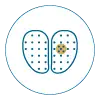Fusion prostate biopsy
Transperineal fusion mapping biopsy is the latest advance in prostate cancer diagnosis
Transperineal mapping biopsy with real-time MRI fusion achieves the highest cost-effectiveness of biopsy by combining, at the time of biopsy, images obtained from prostate MRI and ultrasound.
This test detects the presence of clinically significant prostate cancer in 70% of cases, which means it is more reliable than transrectal biopsy. It also reduces the need for second and third biopsies in patients who are under suspicion for prostate cancer.
A minimally invasive procedure provides us with a highly accurate anatomical map of the prostate with the areas affected by the tumour and allows us to plan the treatment of the tumour in a personalised way.
Contact us if you need more information or advice on the checkup you need.

The most accurate diagnosis for prostate cancer
Combined imaging allows us to perform the biopsy in a much more accurate and cost-effective way

Magnetic resonance imaging
First, an MRI scan is performed, which allows us to visualise the tumour in 85% of cases in order to direct the biopsy.

Ultrasound scan
A transrectal ultrasound is performed and the images ontained are superimposed on the MRI images in a real time.

Fusion biopsy
Perineal samples are taken from the entire prostate, and extra samples are taken from the area under suspicion on the MRI scan.
Advantages of prostate biopsy for the patient
Overview of the process
Fusion biopsy is a minimally invasive procedure that offers significant advantages over traditional biopsy:
- Deep sedation and no need for hospital admission.
- Early recovery of the patient in less than 24 hours.
- It reduces possible complications, mainly infections, as it does not puncture through the rectum.
Personalised treatment
All the information obtained from the fusion biopsy is the preliminary step needed to plan a personalised treatment that includes all the alternatives in the management of the disease:
- Active surveillance.
- Robotic radical prostatectomy with the DaVinci® system.
- Focal therapy.
- High-rate brachytherapy.
- Proton therapy.
- External radiation therapy.